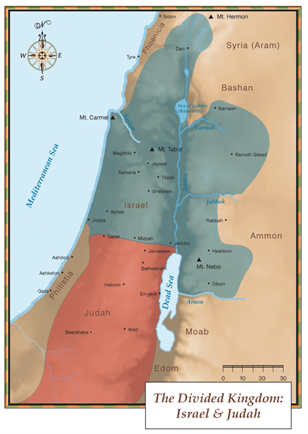To understand the Torah, it is helpful to have a brief history of ancient Israel.
Israel began as a tribal confederacy sometime in the Late Bronze or Early Iron Age (around 1450-1300 BCE[1]). The nation is founded on the myth* that Jews descended from a single patriarch, Abram or Abraham who moved from the city of Ur to the southern Levant (modern day Palestine and Israel). (Arabs and Muslims make this same claim about Abram being their father although by a different maternal ancestor.) The family grew into a collective of 12 different tribes (representing Abraham’s great-grandchildren, sought refuge in Egypt to escape a drought and in the following period became slaves or indentured servants in Egypt. After an unknown length of time, this confederacy escaped Egypt, crossed the Sinai desert and settled back in the southern Palestine.
They were a tribal and agrarian people. Like many tribal societies that do not have written histories and archives, the early Israelites relied on the retelling of sacred stories and myths, and other ceremonies and rituals to pass on beliefs, history, and spirituality.
According to the national myth, Israel existed as a united country for three reigns under Kings Saul, David, and Solomon. However, by around 900 – 850 BCE, a northern kingdom, called “Israel” or “Samaria”, emerged alongside a southern kingdom called Judah. The kingdom of Israel included of 10 of the 12 tribal families. The southern kingdom called Judah was ruled by the tribe of Judah and included the smaller tribe of Benjamin.
For the next two centuries, each country developed somewhat separately while retaining some of its historical culture, religion and folklore but with some notable differences:

The End of the Kingdom of Israel
The Kingdom of Israel came to an end in 722 BCE when it was conquered by the Neo-Assyrian Empire. It is estimated that 20% of the population was deported by Sargon II of Assyria to Mesopotamia. Foreign groups were relocated back to Samaria to dilute the cultural and ethnic identity of the region and prevent any future uprising or rebellion. The Assyrians assimilated the residents of Israel such that they lost almost all of their cultural and religious identity.
It is thought that a group of refugees also fled to Judah where they found a new home and recorded and followed the worship practices of their homeland. There is some speculation that it was these refugees formed the Deuteronomist group that ended up writing the books of Deuteronomy, Joshua, Judges, Samuel, Kings and possibly the Book of Jeremiah.
The End of the Kingdom of Judah
The Kingdom of Judah was a vassal state of Egypt for most of its history but enjoyed a fair degree of religious and cultural independence. However, it too was conquered, this time by the Babylonian Empire, in 589 BCE. Babylon forced the leadership, priesthood, and upper classes into exile in Babylon leaving only peasants and farmers to remain behind.
Eventually Persia conquered Babylon about 50 years later, in 539 BCE. King Cyrus of the Persians allowed the Jewish exiles to return to Palestine.
In 539 BCE, Babylon was itself captured by the Persians under Cyrus the Great. Cyrus issued a decree a year later allowing all Jews in captivity to return to their homeland.
*Myth
How Accurate is Oral History?
Anthropologists have confirmed that non-literate cultures are often able to very accurately record and retain stories even though they do not have the ability or technology to write these stories down. For example, the Franklin Expedition left England in 1845 to search the Canadian Arctic for a “Northwest Passage” and was never heard from again. Over 20 search missions for the HMS Erebus and the HMS Terror were undertaken starting in 1848 through 1878. While some abandoned artifacts were found, the ships themselves were not recovered. More recent searches were undertaken in 1981, 1984, 1986, 1992, 1994, and 1997-2013 using sonar and side-scanning radar without success.
It wasn’t until Parks Canada staff reached out to the indigenous Inuit people of the reason and asked if they had any oral traditions about ships loaded with white men being lost or stuck in the ice, that they learned of the ancestral traditions of where there ships actually sunk. They were then able to locate the HMS Erebus in the summer of 2014, and the HMS terror in 2016.
https://parks.canada.ca/lhn-nhs/nu/epaveswrecks/culture/inuit/gardiens-guardians
